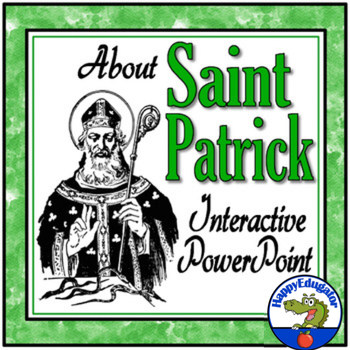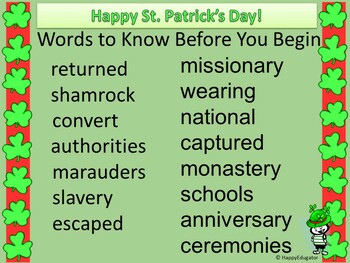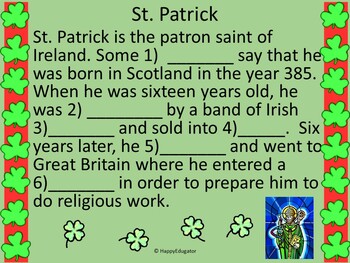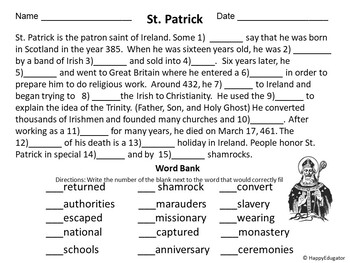St. Patrick's Day Reading Passage Interactive PowerPoint and Worksheets
- PPTX
- Microsoft OneDrive
Description
St. Patrick's Day Interactive PowerPoint with worksheets. A cloze reading activity for March fun and learning. Students use context clues to fill in the blanks of a short reading passage that tells the story about Saint Patrick. Just project on the whiteboard or Smartboard or print out in black and white. Learn the history of St. Patrick's Day while building reading and vocabulary skills. May be used at individual computer stations or project on whiteboard for the whole class. Also includes vocabulary definitions and a vocabulary sheet for students to write in the definitions. Use this digital resource in Zoom or videoconferencing for remote learning. Good homeschool activity, too. Compatible with Microsoft OneDrive. Please see full preview. Note: animations do not show in the preview.
Students copy 15 words from the word bank on their own paper (or print out word bank and accompanying worksheet, ink friendly copies included), and then read the story and match the words to the correct blanks. It is self-checking. You can use the hard copy version for students to work cooperatively in groups. Includes answer key. (Directions and worksheets are at the end.)
Related Products
⭐ St. Patrick's Day Bookmarks Set of 6
⭐ St. Patrick's Day Crossword Puzzle
⭐ St. Patrick's Day Reading Passage Interactive PowerPoint and Printable
⭐ St. Patrick's Day Riddles and Jokes PowerPoint
⭐ St. Patrick's Day Writing Paper - Lined Paper with Drawing Boxes - 20 Designs
⭐ St. Patrick's Day Writing Prompts Lined Paper & Editing Checklist Grades 3 - 5
⭐ St. Patrick's Day Writing Prompts Lined Paper and Editing Checklist Grades K - 3
⭐ St. Patrick's Day Adjectives Hunt Game
⭐ St. Patrick's Day - Map of Ireland - Printable and Digital Easel Activity
⭐ Limerick Poems - How to Write Limericks Templates and Easel Digital Activity
Follow me HERE to get notified of updates, sales, free resources, and new products. All new products are 50% off for 48 hours.
© Deborah Hayes aka HappyEdugator. For classroom and homeschool use. Your purchase buys one license. You may purchase extra licenses at a discount.
Supports Common Core State Standards. CCSS:
CCSSRI.5.4, 6.4, 7.4, 8.4 Determine the meaning of general academic and domain-specific words and phrases in a text.
CCSSCCRA.R.1 Read closely to determine what the text says explicitly and to make logical inferences from it; cite specific textual evidence when writing or speaking to support conclusions drawn from the text.
CCSSCCRA.R.10 Read and comprehend complex literary and informational texts independently and proficiently.
122538





